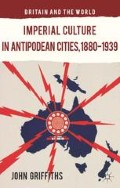Abstract
How far were Antipodean cities ‘imperial’ spaces? In 1948, F.L. Irvine-Smith published her book The Streets of My City, which was declared the ‘first book of its kind in New Zealand’.1 In its examination of the origins of street names, the author effectively charted the early appropriation of public space by the British, whose administrators, governors and politicians, and the ships that brought colonisers to New Zealand were commemorated in the process of street-naming. Many of Wellington’s streets were named after New Zealand company directors and administrators. Irvine-Smith noted that ‘very few Maori names trickled into the nomenclature of the early city streets’, despite the native population being ‘fairly numerous’.2 It tended to be only those tribal leaders who had cooperated with the imperial authorities that merited recognition. With hindsight, it can be seen that a key influence on nineteenth-century and early twentieth-century street-naming was what David Cannadine has characterised as ‘Ornamentalism’, reflected in the appetite to name streets after imperial figureheads, early colonisers and, most significantly, governors general, senior statesmen, the monarch and her family.3
Access this chapter
Tax calculation will be finalised at checkout
Purchases are for personal use only
Preview
Unable to display preview. Download preview PDF.
Notes
D. L. Irvine Smith, The Streets of My City (Wellington: Reed, 1948).
M. Stocker, ‘Queen Victoria Monuments in New Zealand: A Centenary Survey’, History Now, 7(4) (2001), pp. 5–9.
R.T. Ridley, Melbourne’s Monuments (Melbourne University Press, 1996).
M. Lewis, P. Goad and A. Mayne, Melbourne: The City’s History and Development (City of Melbourne, 1994).
P. Bell and R. Bell, Implicated: Americanising Australia (Perth: API-Network, 2007), pp. 26–7.
P. Shaw, New Zealand Architecture: From Polynesian Beginnings to 1990 (Auckland: Hodder & Stoughton, 1991), p. 134.
J. Gatley, ‘For(war)d Thinking; The Ford Building Seaview’ in J. Wilson (ed.), Zeal and Crusade: The Modern Movement in Wellington (Christchurch: Te Waihora, 1996), pp. 21–7.
J. Griffiths, ‘Were There Municipal Networks in the British World c. 1890–1939?’, Journal of Imperial and Commonwealth History, 37(4) (2009) , pp. 575–98
J.M. Freeland, Architecture in Australia (Harmondsworth: Penguin, 1972), p. 249.
P. Goad, Melbourne Architecture (Boorowa, NSW: Watermark Press, 2009), p. 117.
R. Storey, Walking Melbourne: The National Trust Guide to the Historic and Architectural Landmarks of Central Melbourne (Victoria: National Trust, 2004), p. 33.
M.A. Bruce, ‘R. A. Lippencott, The American Connection’ (BArch thesis, University of Auckland, 1985).
I. Lochhead, ‘New Zealand Architecture in the Thirties: The Impact of Modernism’, Landfall, 38(4) (1984), p. 470.
J. Griffiths, ‘Popular Culture and Modernity: Dancing in New Zealand Society 1920–1945’, Journal of Social History, 41(3) (2008), p. 613.
M. Tebbutt, Being Boys: Youth, Leisure and Identity in the Inter-War Years (Manchester University Press, 2012), p. 201.
C. Baade, ‘“The Dancing Front”: Dance Music, Dancing and the BBC in World War II’, Popular Music, 25(3) (2006), p. 353, cited in Tebbutt, Being Boys, p. 209.
R. White, ‘Americanisation and Popular Culture in Australia’, Teaching History (August 1978), p. 13
R. White, ‘A Backwater Awash: The Australian Experience of Americanisation’, Theory, Culture and Society, 1(3) (1983), pp. 108–22.
J.J. Matthews, ‘Which America?’ in P. Bell and R. Bell (eds), Americanisation and Australia (Sydney: USW Press, 1998)
W. Phillips, ‘“Six o’Clock Swill”: The Introduction of Early Closing of Hotels Bars in Australia’, Historical Studies, 19(75) (1980), pp. 250–66;
C. Bollinger, Grog’s Own Country: The Story of Liquor Licensing in New Zealand (Trowbridge: Minerva, 1967).
J.J. Matthews, Dance Hall and Picture Palace: Sydney’s Romance with Modernity (Sydney: Currency Press, 2005), p. 66.
A. Davies, ‘The Scottish Chicago? From Hooligans to Gangsters in Interwar Glasgow’, Cultural History and Social History, 4(4) (2007), p. 519.
J. Richards, Films and British National Identity: From Dickens to Dad’s Army (Manchester University Press, 1997).
D. Collins, Hollywood Down Under: Australians at the Movies 1896 to the Present Day (Sydney: Angus & Robertson, 1987), pp. 37–8.
R. Thorne, Picture Palace Architecture in Australia (Sydney: Sun Books, 1976)
K. Boyd, ‘The Western and British Identity on British Television in the 1950s’ in B. Bebber (ed.), Leisure and Cultural Conflict in Twentieth Century Britain (Manchester University Press, 2012), p. 111.
Kate Flint, The Transatlantic Indian 1776–1930 (Princeton University Press, 2009).
P. Limbrick, Making Settler Cinema: Film and Colonial Encounters in the United States, Australia and New Zealand (Basingstoke: Palgrave Macmillan, 2010).
A. Kuhn, An Everyday Magic: Cinema and Cultural Memory (London: I.B. Tauris, 2002), p. 101.
D. Fowler, The First Teenagers: The Lifestyle of Young Wage Earners in Interwar Britain (London: Woburn Press, 1995), p. 131.
G. Mirams, Speaking Candidly: Films and People in New Zealand (Wellington: Whitcombe & Tombs, 1945), p. 90.
Felicity Barnes, New Zealand’s London: A Colony and its Metropolis (Auckland University Press, 2012), pp. 228–35.
W. Brittenden, The Celluloid Circus: The Heyday of the New Zealand Picture Theatre (Auckland: Godwit, 2008), p. 124.
L. Cleveland, ‘What They Liked: Movies and Modernity Down Under’, Journal of Popular Culture, 36(4) (2003), p. 768.
J. Richards, ‘Patriotism with Profit: British Imperial Cinema in the 1930s’ in J. Curran and V. Porter (eds), British Cinema History (London: Weidenfeld & Nicolson, 1983), p. 252.
Author information
Authors and Affiliations
Copyright information
© 2014 John Griffiths
About this chapter
Cite this chapter
Griffiths, J. (2014). Empire City or Global City? North American Culture in the Antipodean City c. 1880–1939. In: Imperial Culture in Antipodean Cities, 1880–1939. Britain and the World. Palgrave Macmillan, London. https://doi.org/10.1057/9781137385734_4
Download citation
DOI: https://doi.org/10.1057/9781137385734_4
Publisher Name: Palgrave Macmillan, London
Print ISBN: 978-1-349-48136-1
Online ISBN: 978-1-137-38573-4
eBook Packages: Palgrave History CollectionHistory (R0)

